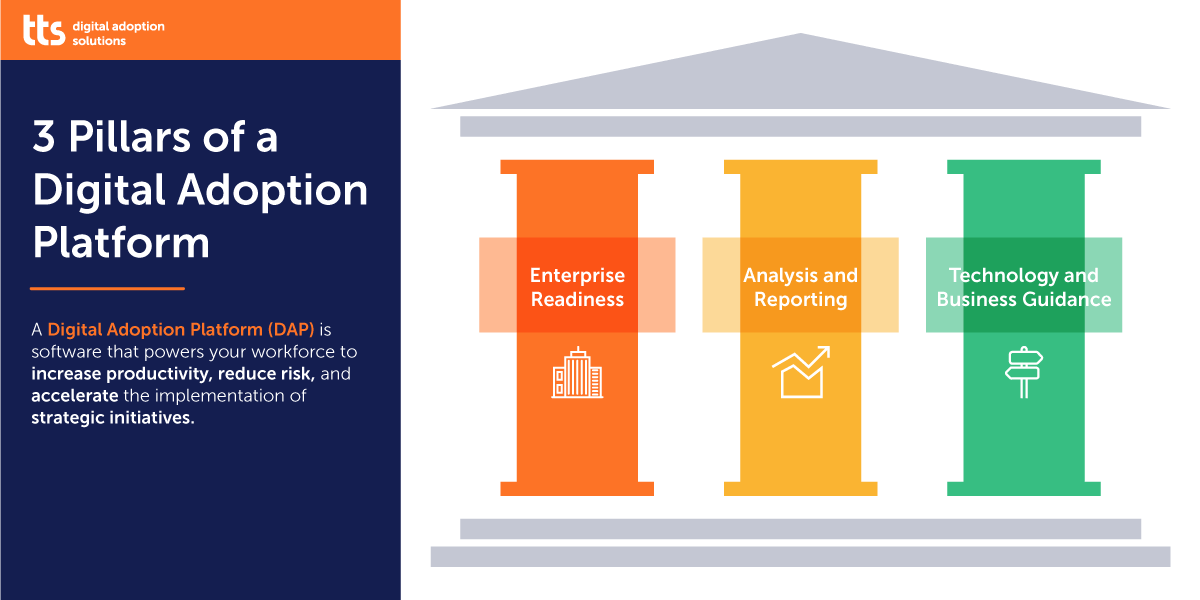The three pillars of a digital adoption platform


Digital transformation is only successful if the rollout of new technologies is accompanied by a change in corporate culture. Digital adoption platforms (DAPs) assist organizations with this complex undertaking. They help them get employees on board with the changes and offer staff support in coming to grips with the new technologies. In other words, they help build digital adoption. According to Gartner, Forrester Research and other analysts, over half of all organizations will be using a DAP by 2025.
Digital adoption platforms – how beneficial are they?
Digital Adoption with tts performance suite
The benefits of a digital adoption platform depend to a large extent on how extensively it is integrated into the system and process landscape.
DAPs are often used during the implementation of individual software solutions, to prevent a dip in performance after the go-live. However, a project-specific approach of this kind entails a number of risks. For example, the assistance users receive with their tasks is isolated rather than extending across a variety of applications. This results in a bad user experience, an inadequate understanding of the process and uncertainty when faced with more complex tasks. What’s more, project-specific use of DAPs means the organization is often operating several digital adoption platforms in parallel. Although opting for isolated integration increases the chances of success in individual projects, it does nothing to change the adaptability of the organization as a whole.
On the other hand, using a digital adoption platform strategically – as part of an organization-wide transformation project, for instance – indicates a move toward extensive integration. With a “think big” approach of this kind, it is possible to reach staff at any digital workplace and encourage an organization-wide mindset of being open to the many major and minor changes that are set to take place at this point and in the future. Only in this way can a DAP also help make an organization more competitive and future-proof on a lasting basis.
The three pillars of a digital adoption platform
A whole host of aspects need to be considered if an organization is to find its ideal DAP. Regardless of the specific factors, though, to ensure a digital adoption platform can be used throughout the organization in the long term, it must be based on the following three pillars:
- Enterprise readiness
- Analysis and reporting capability
- Guidance on technology and business
1. A DAP is enterprise-ready
The value creation potential of a digital adoption platform can only be fully leveraged if it is enterprise-ready – like the tts performance suite, for instance. In other words, the DAP doesn’t just support certain aspects of digital transformation, but rather the organization’s entire transformation process. It can also be scaled easily – that is to say, extended to additional applications, users or businesses without any significant IT outlay. The features of enterprise readiness include:
-
Cross-application capability
Uniform guides in any desired Windows or web application can support users across a variety of processes. -
Open interfaces
Interfaces of this kind, including single sign-on and integration options, make it easy for users to access all internal knowledge sources. This creates a single source of truth and breaks down silos. -
Efficient knowledge transfer
Using various content formats enables knowledge to be transferred efficiently. Different types of learning and knowledge levels can be taken into account on a cross-generational basis.
-
Multilingual approach
Since content can be created in a variety of different languages and displayed in line with the user’s interface language, it is also easy to utilize the DAP around the world. -
IT security and data protection
Applicable requirements such as those of the GDPR and the EU Data Protection Directive are met. What’s more, the DAP does not restrict flexibility and can adapt to the existing tech stack without the need for a derogation. -
Flexible software provision
The DAP is available on both an SaaS and an on premises basis and can be incorporated into an organization’s existing IT architecture without any restrictions.
2. A DAP enables analysis and reporting
A digital adoption platform’s suitability for strategic use within an organization also depends to a great extent on its analysis and reporting functions. These functions help keep track of staff’s usage behavior and knowledge requirements. They also provide important information about the progress of digitalization and lay the foundation for data-based optimization.
A clearly structured dashboard quite literally helps the organization keep an eye on the main KPIs, with visual usage data recorded intuitively based on experience. The organization can immediately see which content is in particular demand, where content is missing and where digital friction potentially exists. Filter functions – e.g. based on roles, segments and locations – help make tailored improvements to content and minimize process interruptions.
3. A DAP provides guidance on technology and business
Most digital adoption platforms support users by showing them the correct way to use a particular new software application – technology guidance pure and simple. If a DAP is to remain effective in the medium term, however, it must offer two types of guidance:
-
A DAP provides comprehensive technology guidance. In other words, it ensures a smooth workflow, even across multiple business applications. This eliminates uncertainties when operating new software.
-
A DAP supplies process-related business guidance. By offering direct access to process knowledge, regulations and organization-specific know-how, it contributes to the autonomous completion of tasks – including independently of the software to be operated. As a result, understanding of the changed ways of working grows.
Supported by a combination of technology guidance and business guidance, staff become very accepting of these changes, which creates a productive synergy between people, processes and technologies.
Conclusion
Besides supporting an organization’s overall strategy, a digital adoption platform must also meet the needs of end users and authors. Only then can it help eliminate uncertainties, break down barriers and initiate the transformation toward a culture that embraces technology.
For this purpose, a DAP must ensure enterprise readiness, offer guidance on technology and business, and enable analyses and reporting. What’s more, it must take the form of a package solution to lay a solid foundation for the challenge of the century – digital transformation.





